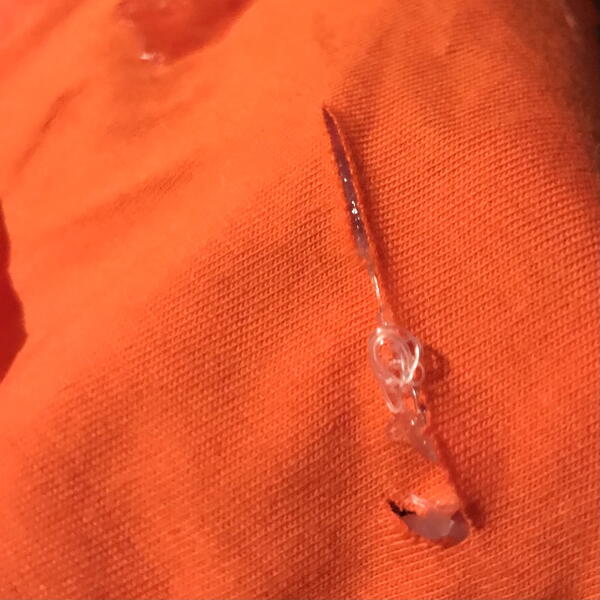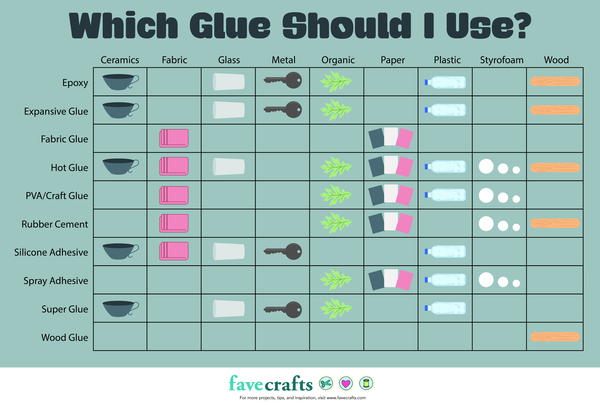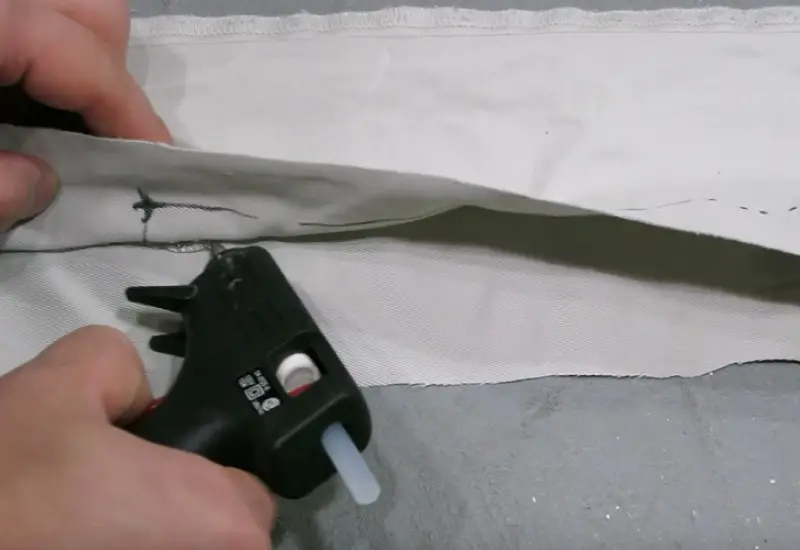Yes, hot glue can work on fabric, but it may not be the most durable option. Hot glue can be used on fabric for temporary or light-duty projects.
For a stronger and longer-lasting bond on fabric, consider using fabric glue or sewing. When using hot glue on fabric, ensure it is not too hot to avoid damaging the material.
It is best to test a small area first to ensure compatibility and effectiveness. Overall, hot glue can be a quick fix for fabric projects, but for more permanent results, consider alternative fabric adhesives or sewing methods.
Contents
- Introduction To Hot Glue And Fabric
- The Adhesion Process
- Pros And Cons Of Using Hot Glue On Fabric
- Selecting The Right Hot Glue For Fabric Projects
- Application Techniques For Success
- Creative Projects With Hot Glue And Fabric
- Troubleshooting Common Issues
- Care And Maintenance
- Frequently Asked Questions
- Conclusion
Introduction To Hot Glue And Fabric
Hot glue can work on fabric, but it is important to choose the right type of glue gun and glue sticks for the job.
Low-temperature glue guns are recommended for delicate fabrics, while high-temperature glue guns are suitable for heavier fabrics.
It’s also important to test a small area before starting your project to ensure the glue will adhere properly.
The Basics Of Hot Glue
Hot glue is a versatile adhesive used in various crafting projects.
It is applied in liquid form and solidifies quickly upon cooling.
Hot glue guns are commonly used to apply hot glue to different materials.
Types Of Fabric Commonly Used In Crafts
Fabric plays a vital role in craft projects, with various types available.
Cotton, polyester, and felt are commonly used fabrics in crafting.
These fabrics offer different textures and strengths for various applications.

The Adhesion Process
Hot glue can be used on fabric for adhesion, providing a strong bond. This versatile adhesive is suitable for various crafting projects and can securely attach fabric pieces together.
How Hot Glue Interacts With Fabric?
Hot glue, also known as hot melt adhesive, is a versatile adhesive that can be used for various crafting projects, including fabric-based ones. When hot glue is applied to fabric, it goes through a specific adhesion process. The adhesion process involves the following steps:
1. Heating the glue: Hot glue sticks are solid at room temperature but turn into a liquid when heated. The glue gun heats the glue stick, melting it and making it ready for application.
2. Applying the glue: Once the hot glue has reached the desired temperature, it is applied directly onto the fabric. The user must be cautious during this step to avoid any burns from the hot glue.
3. Penetration into fabric fibers: As the hot glue is applied, it starts to penetrate the fabric fibers. The liquid glue seeps into the tiny gaps between the fibers, creating a bond as it cools and solidifies.
4. Cooling and solidification: After the hot glue is applied, it cools down rapidly, causing it to solidify. This solidification process happens relatively quickly, forming a strong bond between the fabric and the glue.
Factors Affecting Adhesion Strength
The strength of the adhesion between hot glue and fabric can vary depending on several factors. These factors can influence the longevity and durability of the bond. Here are some key factors to consider:
1. Fabric type: Different types of fabrics have varying levels of porosity, texture, and composition. Fabrics with a looser weave or more porous surface may provide better adhesion compared to tightly woven or water-repellent fabrics.
2. Temperature: Hot glue relies on heat to melt and create a bond. Extreme temperatures, whether high or low, can affect the adhesion process. It is essential to apply hot glue within the recommended temperature range specified by the manufacturer.
3. Surface preparation: Proper surface preparation can improve adhesion. It is advisable to clean the fabric surface from any dirt, oils, or other contaminants that may hinder the bond. Additionally, roughening the surface slightly can enhance the adhesive grip.
4. Amount of glue applied: The amount of hot glue applied plays a role in the adhesion strength. Applying an adequate amount of glue ensures better coverage and a stronger bond. However, excessive application can lead to visible glue lines or seepage through the fabric.
5. Stress and flexibility: Consider the anticipated stress and flexibility the fabric will undergo. Hot glue may perform well on fabrics that experience minimal movement or stress, but it may not be suitable for highly flexible or stretchable fabrics.
Overall, understanding how hot glue interacts with fabric and the factors that influence adhesion strength is crucial for successful fabric-based projects. By considering these factors and following best practices, you can ensure a secure and lasting bond between hot glue and fabric.
Pros And Cons Of Using Hot Glue On Fabric
When it comes to crafting and sewing, hot glue can be a convenient tool for adhering fabric. However, it’s essential to weigh the advantages and limitations of using hot glue on fabric to ensure a successful outcome. Let’s explore the pros and cons of using hot glue on fabric.
Advantages Of Hot Glue For Fabric
Hot glue is a versatile adhesive that can bond fabric quickly and effectively. Here are the advantages of using hot glue on fabric:
- Quick adhesion: Hot glue dries rapidly, allowing for efficient bonding of fabric materials.
- Ease of use: Applying hot glue is a straightforward process, making it suitable for various crafting and sewing projects.
- No sewing required: Hot glue can serve as an alternative to sewing, especially for quick fixes and temporary fabric bonding.
- Versatility: It can be used to attach embellishments, trims, and patches to fabric with precision.
Limitations And Considerations
While hot glue offers benefits, there are important limitations and considerations to keep in mind:
- Durability: Hot glue may not provide a long-lasting bond on certain fabrics and can weaken over time, especially with frequent washing or exposure to heat.
- Flexibility: It may create a stiff or rigid feel on fabric, impacting the drape and overall flexibility of the material.
- Heat sensitivity: Some fabrics are sensitive to heat, and the use of hot glue may cause damage or discoloration.
- Not suitable for all fabrics: Certain delicate or heat-sensitive fabrics may not be compatible with hot glue, necessitating alternative adhesive options.
Selecting The Right Hot Glue For Fabric Projects
When it comes to using hot glue on fabric, selecting the right type of glue is crucial for a successful project. Choosing the appropriate hot glue stick can make a significant difference in the outcome of your fabric crafts.
Types Of Hot Glue Sticks
There are various types of hot glue sticks available in the market, each designed for specific purposes. Understanding the different types can help you select the most suitable one for your fabric projects.
Tips For Choosing The Best Glue
- Consider the temperature: Opt for low-temperature hot glue sticks to prevent damage to delicate fabrics.
- Check for flexibility: Choose a glue that remains flexible after drying to ensure the fabric’s natural movement.
- Look for washability: If your project requires washing, select a glue stick that is washable for longevity.
- Adhesion strength: Ensure the glue provides a strong bond suitable for the fabric type you are working with.
Application Techniques For Success
When it comes to using hot glue on fabric, applying it effectively is crucial to ensure a strong and long-lasting bond. By following the right techniques, you can achieve great results and create beautiful fabric crafts. In this section, we will discuss the steps you need to take for successful application of hot glue on fabric.
Preparing The Fabric
Before applying hot glue on fabric, it’s important to prepare the surface properly. Here are the steps to follow:
- Clean the fabric: Make sure the fabric is free from any dirt, dust, or debris. This will help the glue adhere better.
- Test a small area: Before applying hot glue on the entire fabric, it’s recommended to test a small, inconspicuous area. This will allow you to check if the glue bonds well with the fabric without causing any damage.
- Heat the glue gun: Plug in your glue gun and allow it to heat up according to the manufacturer’s instructions. A hot glue gun that is at the right temperature will ensure proper adhesion.
Applying Hot Glue Effectively
Once the fabric is prepared, it’s time to apply the hot glue. Follow these techniques for successful application:
- Apply the glue in small sections: Instead of applying a large amount of glue at once, work in small sections. This will give you better control and prevent the glue from drying too quickly.
- Use a steady hand: Hold the glue gun with a steady hand and apply even pressure to create a uniform bond.
- Avoid excessive glue: While it’s important to ensure proper adhesion, using too much glue can result in a messy appearance. Apply a thin, even layer for the best results.
- Work quickly: Hot glue dries fast, so work efficiently to bond the fabric before the glue cools down.
- Secure the bond: After applying the glue, press the fabric firmly together to ensure a strong bond. You can use a clean cloth or your fingers to hold the fabric in place until the glue sets.
By following these application techniques, you can successfully use hot glue on fabric and create a variety of beautiful projects. Remember to always prioritize safety when working with hot glue and follow the manufacturer’s instructions for the best results.
Creative Projects With Hot Glue And Fabric
Hot glue is an essential tool for crafters and DIY enthusiasts. It is a versatile adhesive that can bond a wide range of materials, including fabric.
Whether you want to modify your clothes or decorate your home, hot glue can help you achieve your creative goals. Here are some ideas for creative projects you can do with hot glue and fabric.
Diy Clothing Modifications
If you want to give your clothes a new look without spending a lot of money, hot glue can be your best friend. You can use it to add embellishments, patches, or even create a new design on your shirt, dress, or jeans.
Here are some ideas for DIY clothing modifications using hot glue:
- Attach lace or ribbon to the hemline of your skirt or shorts
- Add patches to your denim jacket or jeans
- Create a unique design on your plain t-shirt using different fabrics and hot glue
- Embellish your shoes with fabric flowers or bows
Home Decor Ideas
Hot glue can also be a great tool for home decor projects. You can use it to create unique and personalized decorations for your home. Here are some ideas:
| Project | Instructions |
| Fabric-covered lampshade | Cut your fabric to size, apply hot glue to the lampshade, and wrap the fabric around it, smoothing out any wrinkles. |
| Fabric-covered picture frame | Cut your fabric to size, apply hot glue to the back of the frame, and wrap the fabric around it, securing it with more hot glue. |
| Fabric-covered storage boxes | Cut your fabric to size, apply hot glue to the box, and wrap the fabric around it, tucking in the edges and securing them with hot glue. |
As you can see, hot glue can be a great tool for a wide range of creative projects. With a little bit of imagination and creativity, you can use hot glue to transform your clothes and your home.
Troubleshooting Common Issues
When using hot glue on fabric, it’s not uncommon to encounter some common issues. Troubleshooting these problems can help ensure a successful and durable bond between the fabric and the hot glue. Let’s take a look at some of the typical issues that may arise and how to address them.
Glue Not Sticking
If you find that the hot glue is not sticking to the fabric as expected, there are a few potential causes to consider. First, make sure that the glue gun has reached the appropriate temperature for fabric adhesion.
Using a high-temperature setting can often resolve this issue. Additionally, double-check that the fabric surface is clean and free from any debris or oils that could inhibit adhesion. Applying more pressure while bonding the fabric and glue can also help promote a stronger bond.
Fabric Damage Prevention
When working with hot glue on fabric, it’s essential to take precautions to prevent any damage to the fabric. Avoid using excessive amounts of glue, as this can seep through the fabric and create a mess. Instead, apply the glue sparingly and in a controlled manner.
When pressing the fabric together, use a gentle touch to avoid causing any stretching or distortion. Consider protecting the surrounding fabric with a barrier, such as parchment paper, to prevent accidental glue transfer.

Credit: www.favecrafts.com
Care And Maintenance
When it comes to caring for fabric items that have been bonded with hot glue, it’s important to understand the proper care and maintenance procedures to ensure the longevity of the bond and the fabric itself.
Cleaning Up Excess Glue
In the event of excess hot glue on fabric, it’s important to act quickly to remove it. Gently scrape off any hardened glue using a blunt edge, such as a butter knife or the edge of a credit card.
Be cautious not to damage the fabric in the process. For any remaining residue, apply a small amount of rubbing alcohol to a cotton swab and dab at the glue until it lifts off. Avoid using excessive force to prevent damaging the fabric fibers.
Long-term Care For Glued Fabric Items
To maintain the bond between the fabric and hot glue over time, it’s crucial to handle the items with care. Avoid subjecting the bonded area to excessive stress or tension, as this can weaken the bond. When washing fabric items bonded with hot glue, it’s best to hand wash them using a mild detergent and cold water.
Avoid using harsh chemicals or high heat, as these can compromise the adhesive bond. Allow the item to air dry naturally, and avoid exposing it to direct sunlight for extended periods, as this can cause the fabric to fade and the glue to soften.
Frequently Asked Questions
How Do You Get Hot Glue To Stick To Fabric?
Apply hot glue directly to fabric and press firmly for a strong bond. Preheating fabric can help enhance adhesion.
Can You Hot Glue Fabric Instead Of Sewing?
Yes, you can use hot glue to bond fabric instead of sewing. It’s quick and easy for small projects, but may not be as durable for heavy use.
What Hot Glue Is Best For Fabric?
The best hot glue for fabric is a high temperature adhesive. It provides a strong bond and can withstand the heat generated by ironing.
Use a glue gun with a high temperature setting to ensure the glue melts properly. Always test on a small area before applying to the entire fabric.
Is Hot Glue Or Super Glue Better For Fabric?
Hot glue is better for fabric as it provides a strong bond and is flexible. Super glue can be too rigid and may not hold up well on fabric.
Conclusion
Hot glue can be effective on fabric for certain projects, but it’s important to consider the fabric type and intended use. With proper application and care, hot glue can provide a strong and durable bond on fabric, making it a versatile option for crafting and DIY projects.

